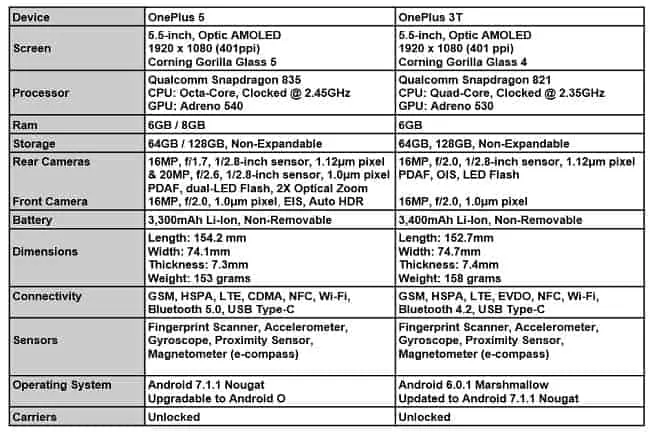Introduction
After a multitude of unofficial rumors and official teasers over the past several weeks, Chinese smartphone vendor OnePlus has finally unveiled its latest flagship smartphone, the OnePlus 5. As is often the case, most of the latest rumors about the device were spot on, so there’s no real surprise element here, but that’s not necessarily a bad thing. The OnePlus 5 will go on sale globally from the 27th of this month, replacing the OnePlus 3T that was launched late last year. But is it really a ‘flagship killer’ that the company and its legions of fans from around the world insist on calling every new OnePlus handset? Is it really a major improvement over its immediate predecessor that was launched barely seven months ago? Is it really a compelling buy at the $479 price-point? While it’s difficult to say anything about the OnePlus 5 with any degree of certainly at this stage because we’re yet to get our hands on it for any length of time, we can always take a general look at the phone’s spec-sheet to see how it compares with its predecessor, at least on paper.
Specifications
OnePlus 5
The OnePlus 5 is finally official, and as expected, it comes with a spec-sheet that will put most flagships from reputable manufacturers to shame. The device is one of the very first smartphones (along with the ASUS ZenFone AR and the Nubia Z17) to offer an 8GB RAM variant. It’s kind of incredible when you think of it, seeing as even mid-range laptops are still shipping with 4GB of RAM for the most part. However, it’s not just about what lies under the hood in this device, but also how it looks on the outside that has got a lot of attention from the media and the general public alike. Many have been quick to point out the phone’s uncanny resemblance to the iPhone 7 Plus, and to be honest, those observations are not entirely off the mark.
One has to admit here that the positioning of the dual-camera module, the placement of the antenna bands and the overall form factor does come eerily close to the general design aesthetic of Apple’s current flagships, but that won’t necessarily be a deal-breaker for many. As was already confirmed by leaked renders earlier this month, the OnePlus 5 has a physical home button that comes with an integrated fingerprint scanner. Keeping in line with the latest trend of vanishing bezels, OnePlus also gets rid of any unnecessary plastic or metal on the two sides of its latest flagship, giving it a very modern look. The front-facing camera, earpiece and proximity sensors are placed on the top, the volume rocker and the trademark OnePlus ‘Alert Slider’ sit on the left edge, and the power key can be found on the right.
While the general design language of the OnePlus 5 is more inoffensive than eye-catching, what will definitely convince many people to give it a good, hard look is the hardware on offer. The device is powered by the Qualcomm Snapdragon 835 SoC – the exact same chip that powers some of the best smartphones in the market today, including the Galaxy S8, Galaxy S8 Plus, Xperia XZ Premium and the HTC U11. The chip is also expected to power upcoming flagships from ASUS, Xiaomi, OPPO and other leading smartphone vendors from around the world. The SoC comes with a 64-bit CPU with eight custom Kryo 280 cores, four of which are clocked at 2.45GHz and four others at 1.9GHz. There’s also an Adreno 540 GPU to take care of all the graphics processing needs. The device will be offered in two different versions – one with 6GB of RAM and 64GB of internal storage, and another, with 8GB of RAM and 128GB of built-in storage.
As for the display panel, the OnePlus 5 features a 5.5-inch 1080p screen with a range of DCI-P3 colors to ensure color accuracy. The screen is also protected by Corning Gorilla Glass 5 to safeguard it from scratches and minor impacts. The company is also putting a lot of emphasis on the imaging capabilities of its latest flagship. The device sports a dual-camera module on the back, as mentioned earlier. While one of them is a 16-megapixel Sony sensor with an f/1.7 aperture, the other one is a 20-megapixel telephoto lens with an f/2.6 aperture. According to OnePlus, the dual rear-camera module on its latest phone represents “the highest resolution dual-camera system on a smartphone today.” As for the operating system, the device comes with Android 7.1.1 Nougat pre-installed in the form of Oxygen OS.
The rest of the features of the OnePlus 5 are also along expected lines, with a long list of connectivity features that include Wi-Fi 802.11 a/b/g/n/ac, Wi-Fi Direct, DLNA and Bluetooth 5.0, while cellular connectivity includes support for 34 frequency bands to ensure compatibility with dozens networks around the world. The device also supports GPS with A-GPS and GLONASS, while an NFC chip ensures you can use it for Android Pay. The device also ships with a USB Type-C port for charging and data syncing, but unlike many other flagships of recent vintage, keeps the 3.5mm port, so you won’t need an adapter to use your older headphones and audio systems with it. The OnePlus 5 carries a non-removable 3,300mAh battery and measures 152.2mm in length, 74.1mm in width and 7.3mm in thickness while weighing in at 153 grams.
OnePlus 3T
The OnePlus 3T was launched last November as a mid-cycle refresh of the OnePlus 3, and is only a relatively small upgrade over its predecessor for the most part. It looks fairly similar to the OnePlus 3 on the outside, but comes with enhanced firepower under the hood. The device is carved out of a single slab of aluminum alloy and feels every bit as premium as it looks. While the power button is placed on the right edge of the OnePlus 3T, the standard volume rocker is placed on the left edge, and just below that, there’s an Alert Slider that can be used to toggle between silent and Do-not-Disturb modes. The device also comes with the option to use either on-screen navigation keys or the capacitive hardware buttons that flank the physical Home button with an integrated fingerprint scanner.
Taking a look at the hardware on the OnePlus 3T, the device comes with a 5.5-inch Optic AMOLED display with Corning Gorilla Glass 4 protection. The panel comes with a resolution of 1080 x 1920 pixels, giving it a pixel density of 401dpi. It’s powered by the Qualcomm Snapdragon 821 SoC, which comes with an integrated CPU that incorporates four custom Kryo cores, two of which are clocked at 2.16GHz and two others, at 2.15GHz. The chip also has an Adreno 530 GPU that takes care of all the graphics processing needs. Much like the OnePlus 5, the base version of the OnePlus 3T also ships with 6GB of RAM and 64GB of storage, but unlike its successor, there’s no change in the amount of RAM available in the 128GB model of this device.
Connectivity features on the OnePlus 3T include Wi-Fi 802.11 a/b/g/n/ac, Wi-Fi Direct, DLNA, Bluetooth 4.2 and GPS with A-GPS and GLONASS, while sensors include a fingerprint scanner integrated into the Home button on the front and an NFC chip that makes the device compatible with mobile payment platforms. There’s also an accelerometer, a gyroscope, a proximity sensor and a magnetometer (e-compass). The device also comes with an USB Type-C port for charging and data syncing and, also has a 3.5mm port for audio output. The device carries a non-removable 3,400mAh battery and originally shipped with Android 6.0.1 Marshmallow in the form of Oxygen OS 4.15, although, it has since received the Android 7.1.1 Nougat update. The device measures 152.7mm in length, 74.5mm in width and 7.4mm in thickness, while weighing in at 158 grams.
… And The Winner Is …
The Final Word
The OnePlus 3T was certainly an excellent choice at the time of its launch, and continues to remain a great smartphone to this day, handling any task you can throw at it with absolute ease. However, the OnePlus 5 is the runaway winner here with the powerful new hardware components and thoughtful new software features. Sure, it isn’t perfect insofar as if doesn’t have water-proofing or an expansion slot, but hey, it’s got a 3.5mm audio port! But seriously, all things considered, it’s hard to ignore all the lucrative hardware at the price OnePlus is asking for. After all, the device will cost just $479 in the U.S. and €499 in the Europe. Having said that, we’ll need to take it for a spin to say for certain whether it will really be as attractive a proposition in reality as it looks on paper, but for that, you’ll have to keep an eye out for our comprehensive review that will come shortly. For now, though, it definitely looks like we’ve got a new king of the budget flagships and although it remains to be seen whether it will indeed be a ‘flagship killer’, there’s very little doubt that OnePlus has yet another hit on its hands.
Buy The OnePlus 5 By The OnePlus 3T




